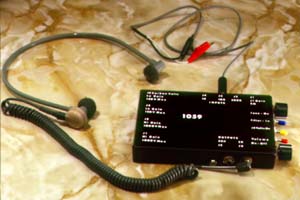

Basic Countermeasures Equipment

1059 - AUDIO PREAMPLIFIER
General purpose preamplifier. Features high gain (over 100 dB) and low noise. Selectable input impedance ranging from 1K to 500K ohms and output impedance from 20K to 2K ohms. Includes switchable hi/lo pass filter, tone generator and excitation voltage output to power external accessories such as the 1059 IR infrared probe. Unit is supplied with special 2K headset and clip-lead input cable. A single 9-volt battery powers the unit. Size is 3/4 x 3 x 5 inches.
The 1059 has been designed as a multiple input/output low noise amplifier that can provide a near perfect match to just about any microphone or recorder. The 1059 includes a tone generator for testing amplifier performance and unknown lines, switchable excitation voltage for external accessories and a low pass/high pass filter selector.
The input jacks, J1 through J4, provide input impedances from 2 Megohms down to 1,000 ohms. Maximum amplification is provided through J2 and J3 and medium gain through J4. J1 and its associated J1 GAIN control has adjustable amplification. With the J1 GAIN control advanced fully clockwise the output level of a signal fed into J1 will be roughly one-half that of the same signal fed into J2.
J1 can sustain approximately 1,000 volts DC. This jack should be used when it is uncertain as to how much voltage or type of signal is on an unknown line pair To operate the 1059, insert the 2,000 ohm headset supplied into output jack J6. The headset is worn with the gray tube under the chin with the sound output holes facing slightly forward. The 1059 is NOT designed to drive low impedance headphones. Turn J1 GAIN fully counterclockwise (minimum) and advance the VOLUME control clockwise (turning on the amplifier) roughly one-third turn. Advance the J1 GAIN control slowly clockwise until either a signal is recovered or the control reaches full clockwise. If, while advancing J1 GAIN, a loud hum is heard, it probably indicates that the line is carrying high voltage AC. USE CAUTION! Do not apply high level AC signals to any other input.
J2 (500K) is a high impedance input which utilizes the maximum amplification of the 1059. This jack is used when the DC and AC level and relative signal strength on a line pair is known. J2 may also be used with external accessories such as the 1040-2 Contact Microphone and 1040-4 Hot-Pack.
J3 is used when the line or accessory is in the vicinity of 10K ohms This jack is used with accessories such as the 2030 Carrier-Current Probe or when analyzing telephone systems.
J4 provides lower amplification and impedance (1,000 ohms) than J2 of J3. It is used when an input signal is too high in level for the other inputs. This jack also has the capability of supplying an excitation voltage (9 volts through 4,700 ohms) for external accessories or carbon microphones. The voltage is supplied to the jack when the J4 VOLTS switch is in the UP position.
The TONE-ON switch powers an internal tone generator. The output of the generator is fed through the last three stages of the amplifier and applied to both output jacks, J5 and J6.
The FILTER-IN switch selects the amplifier roll-off characteristics. This switch is used when excessive hum is encountered or when a more "crisp" signal is desired.
A convenient check of the battery can be made by inserting the mini plug-clip lead cable (supplied) into J4, turning ON the 1059 power and placing the J4 VOLTS switch in the UP position. Connect the clips to a voltmeter set on the 9 or 12 volt range. The voltage should indicate not less than 8 volts for an alkaline battery or 7.5 volts for a mercury battery. Should it become necessary to change the battery, loosen the two cover screws one or two turns, slip off the cover and remove the old battery. Install fresh battery, replace cover and tighten screws (don't over-tighten!).
|
To be contacted for a confidential consultation please E-mail: jmatk@tscm.com
or send a letter via US Mail to:
or call:
URL: http://www.tscm.com/ |